
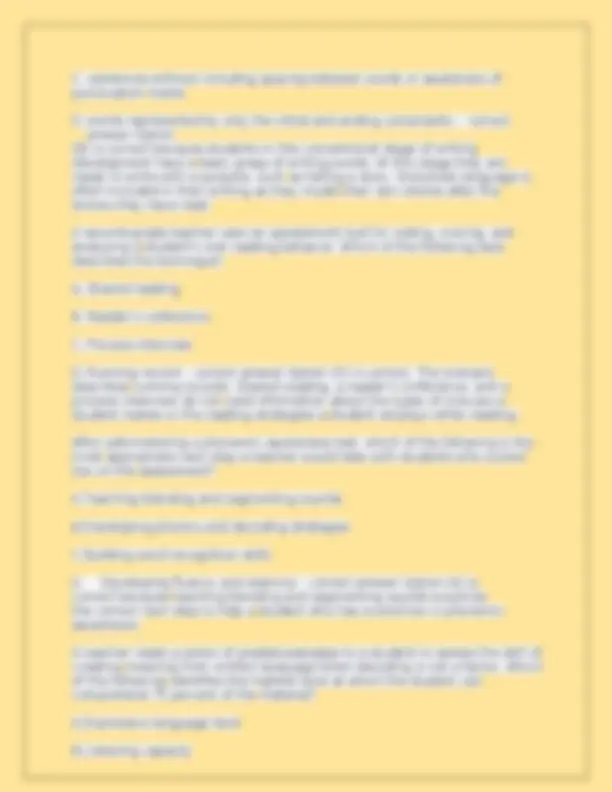
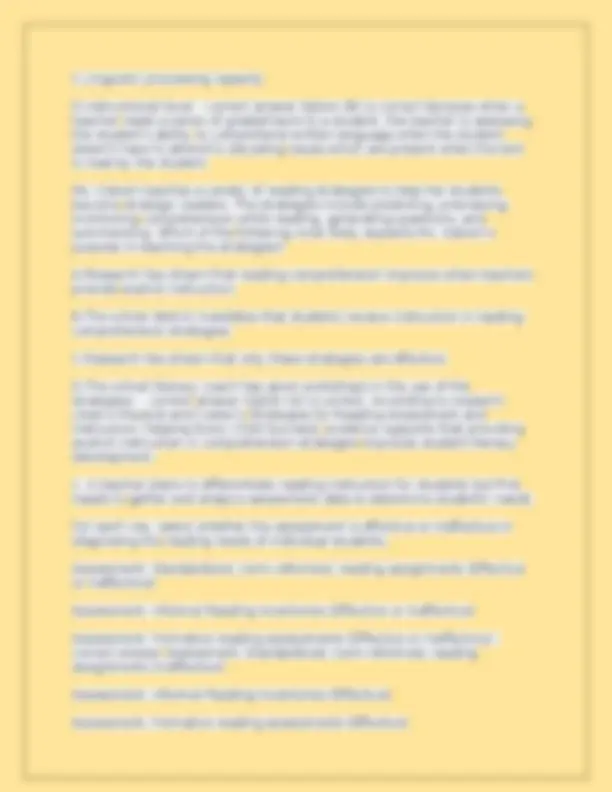

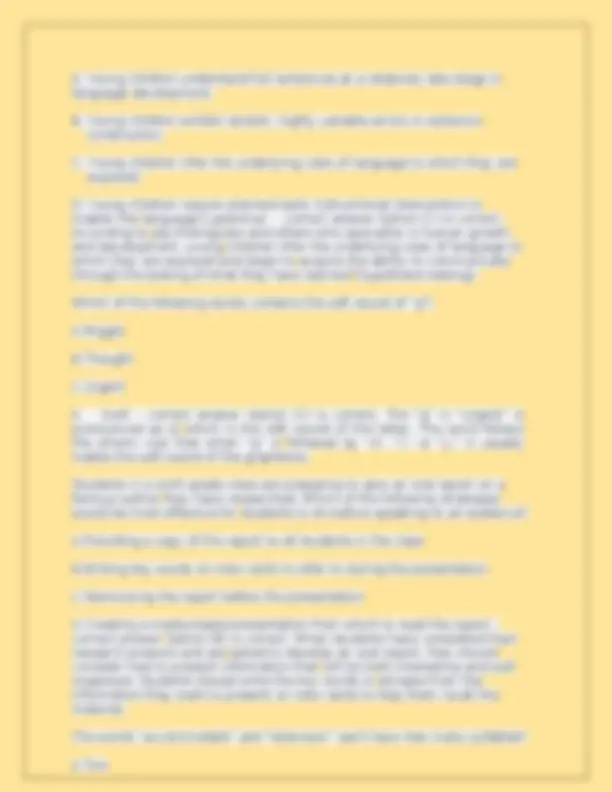
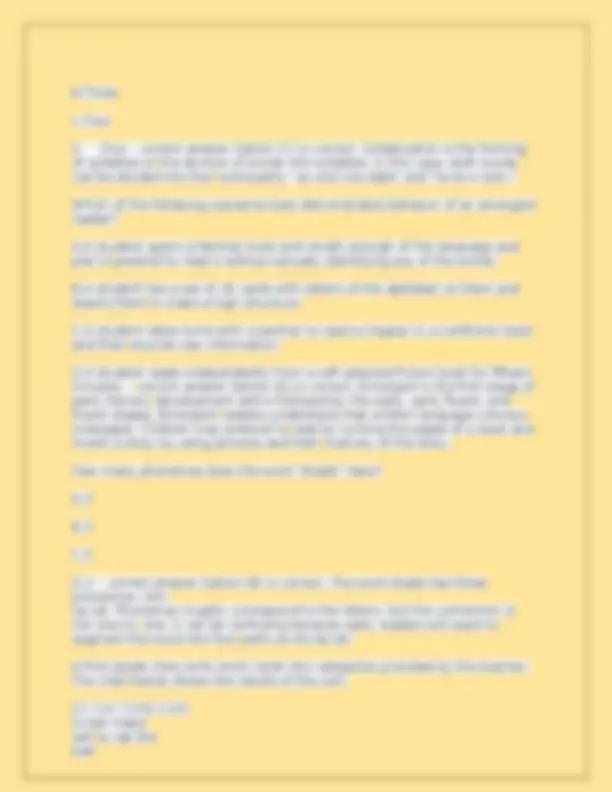
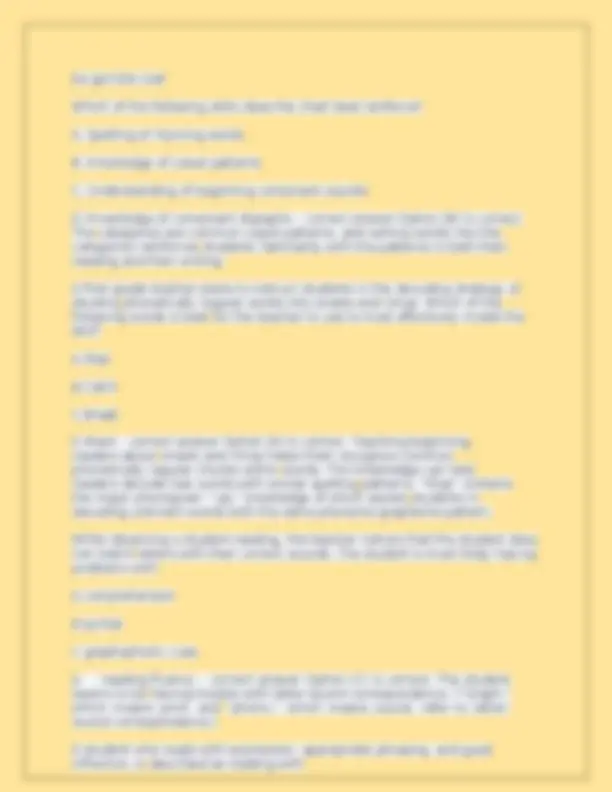
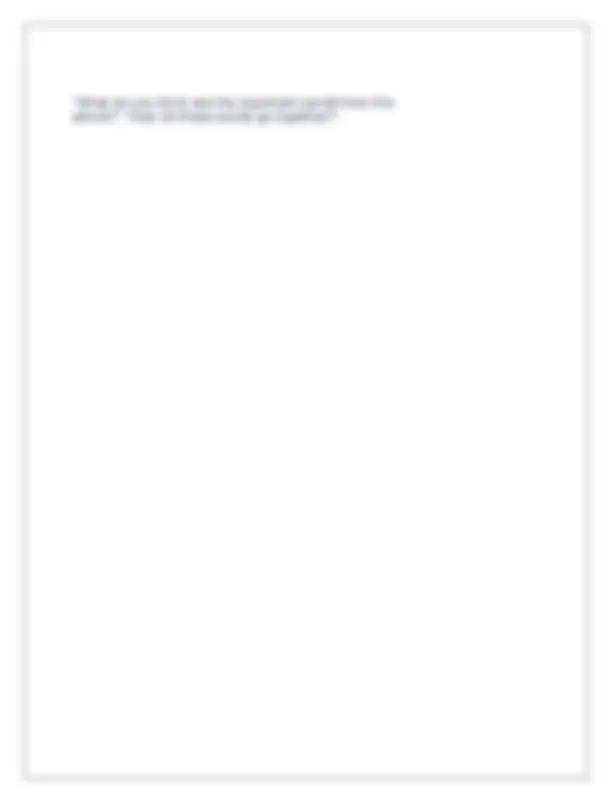
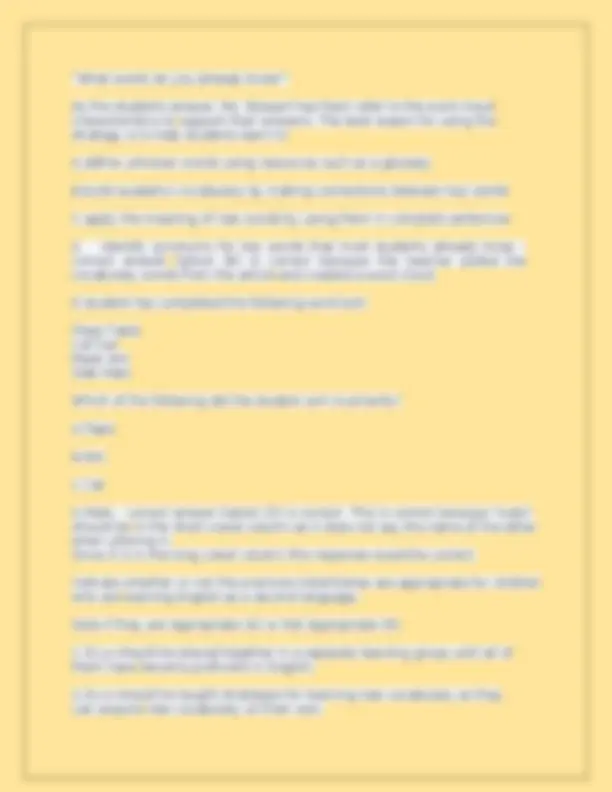
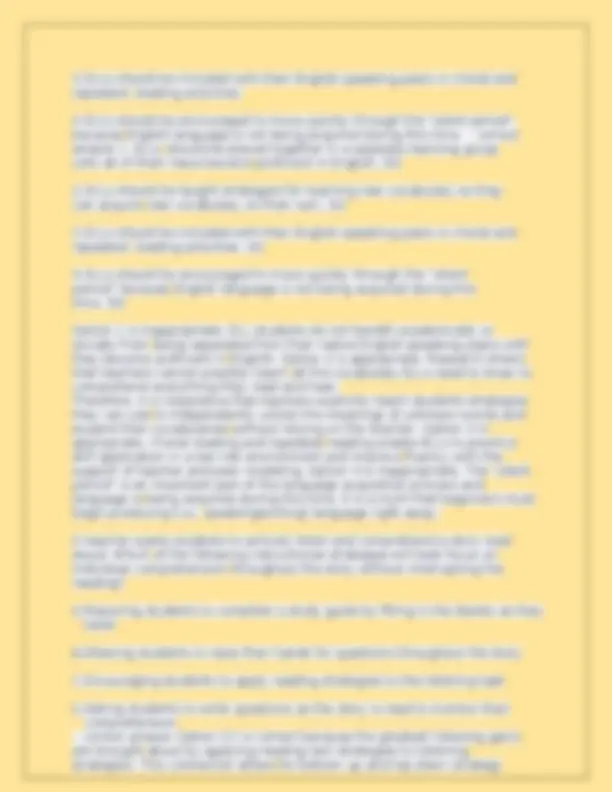
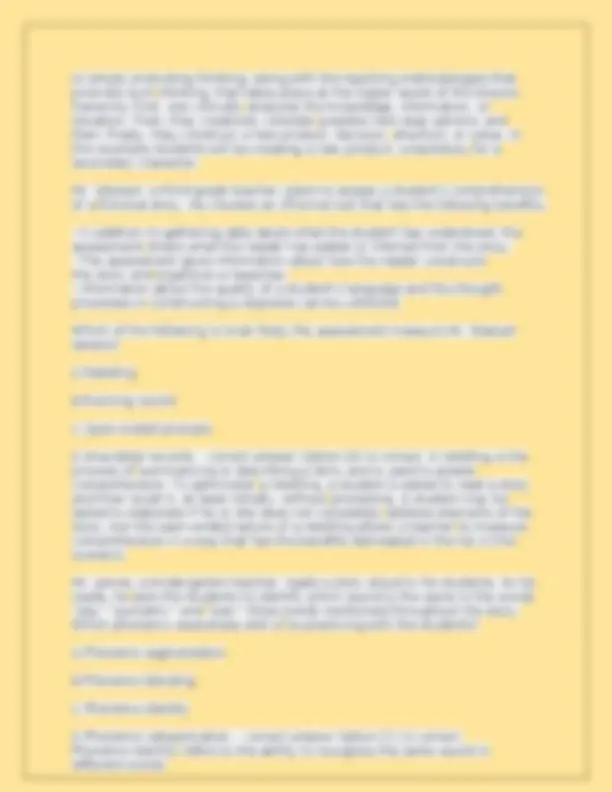
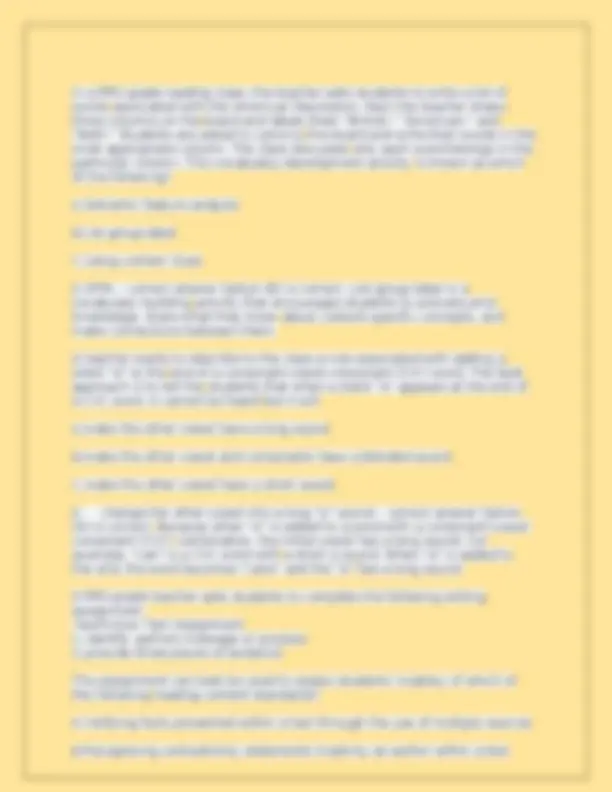
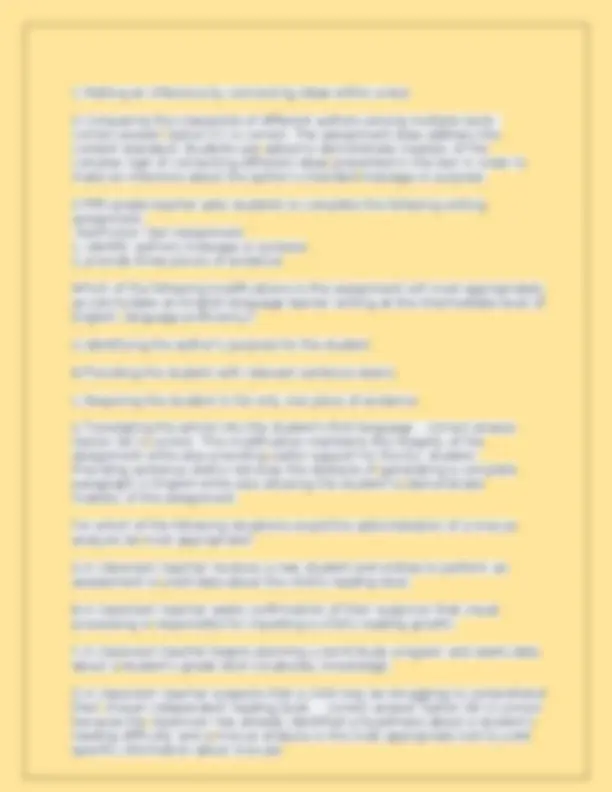
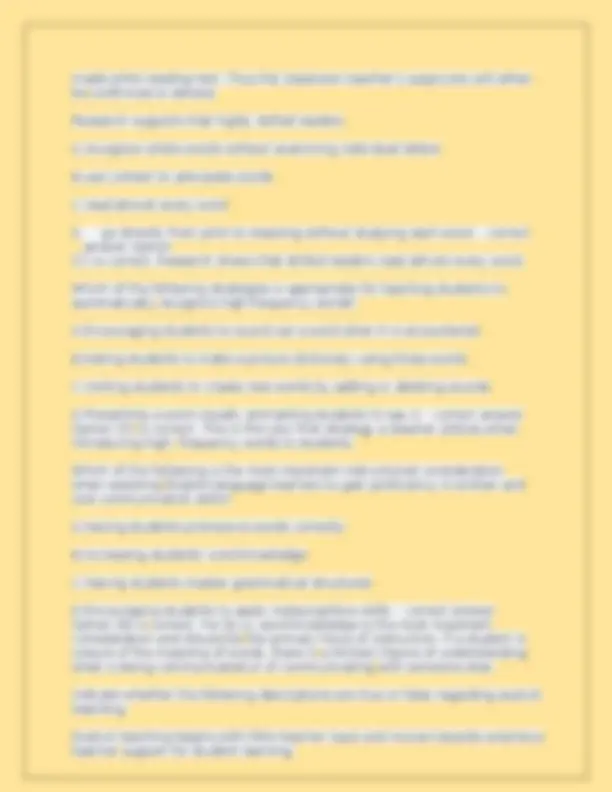
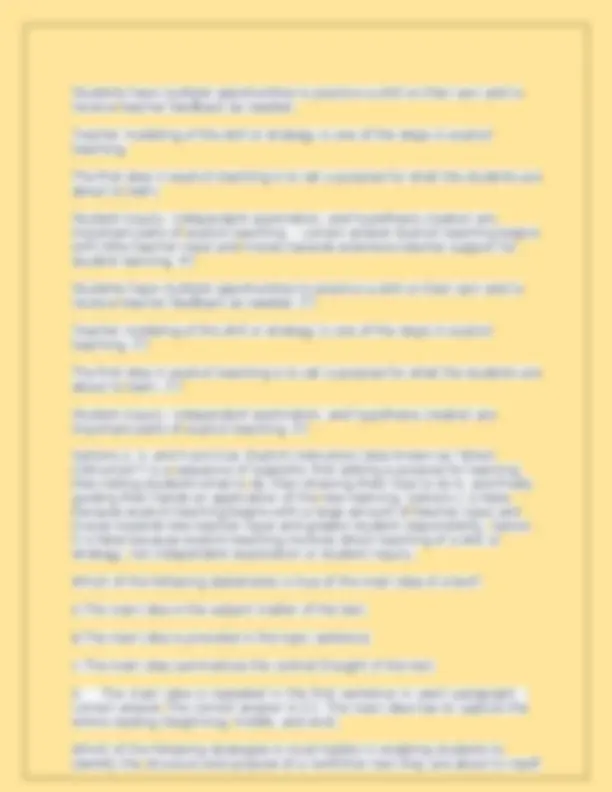
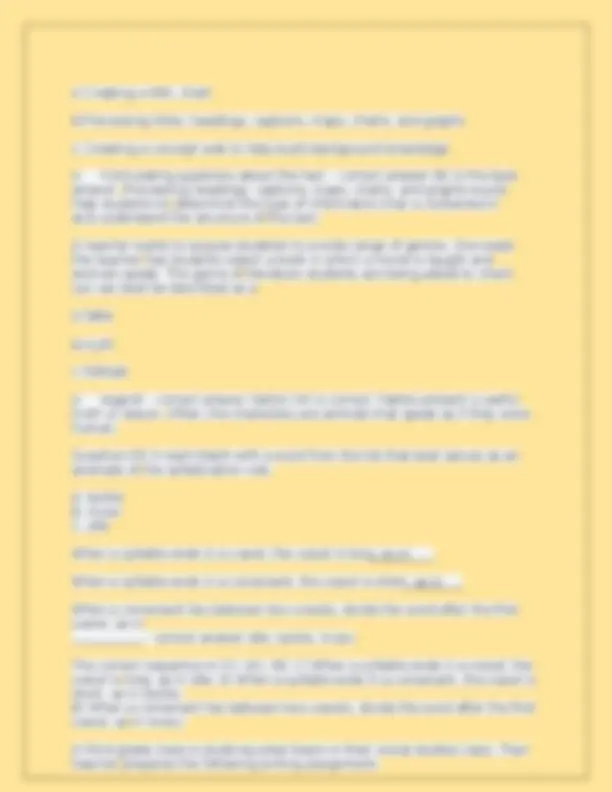
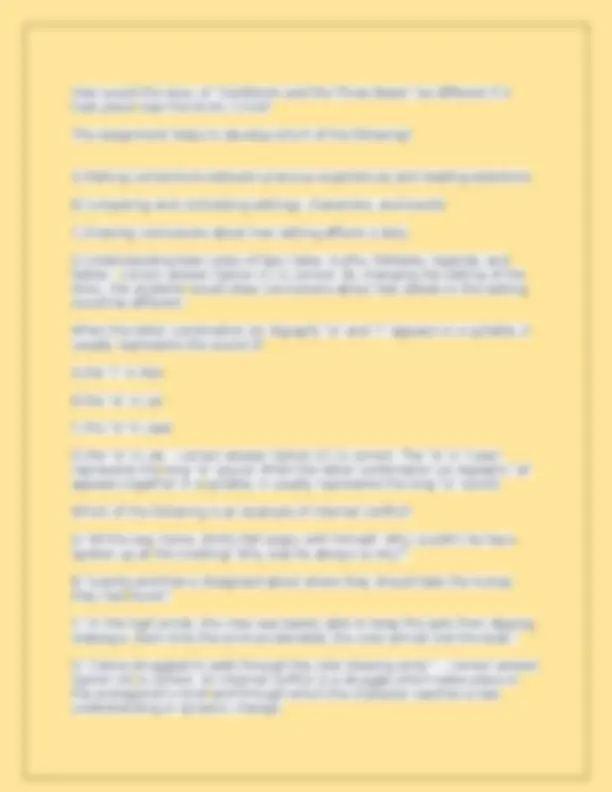
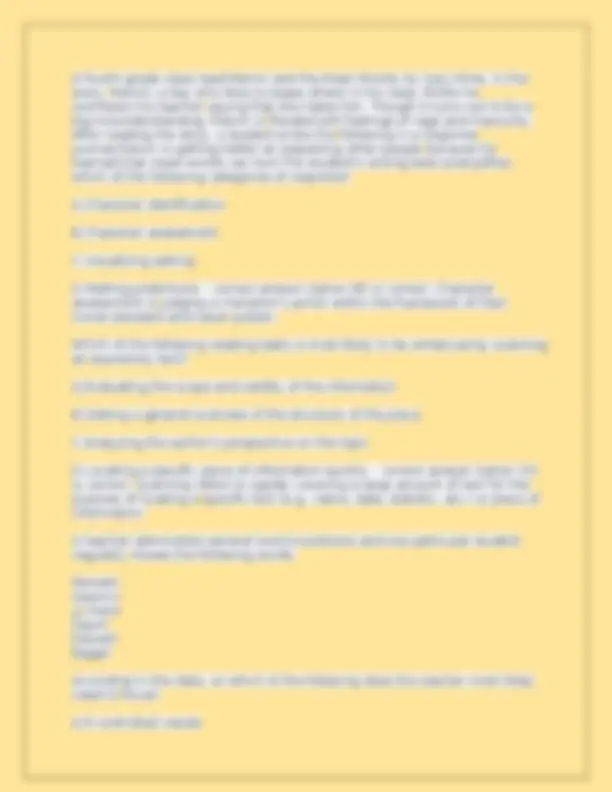
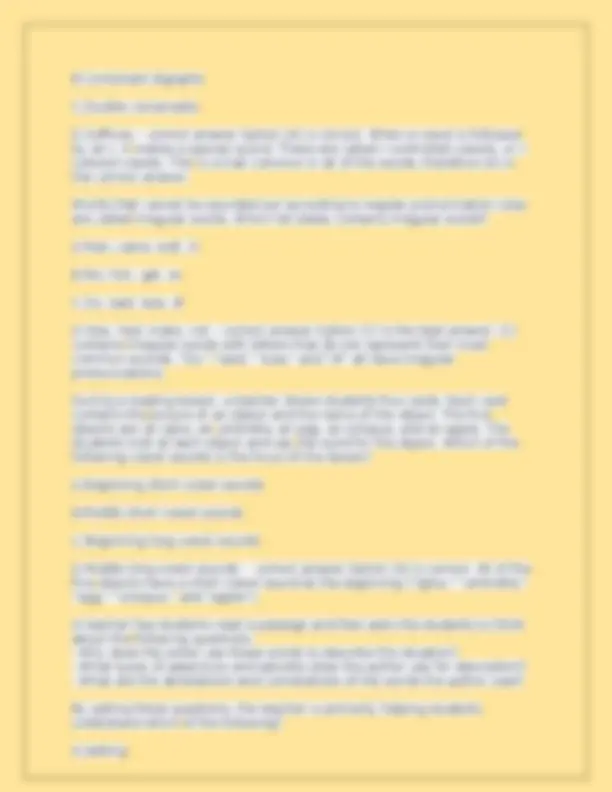
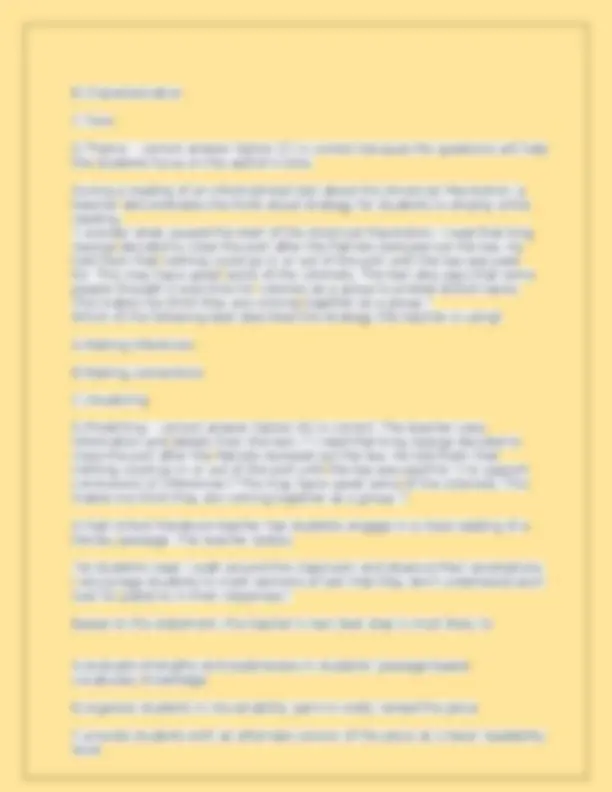
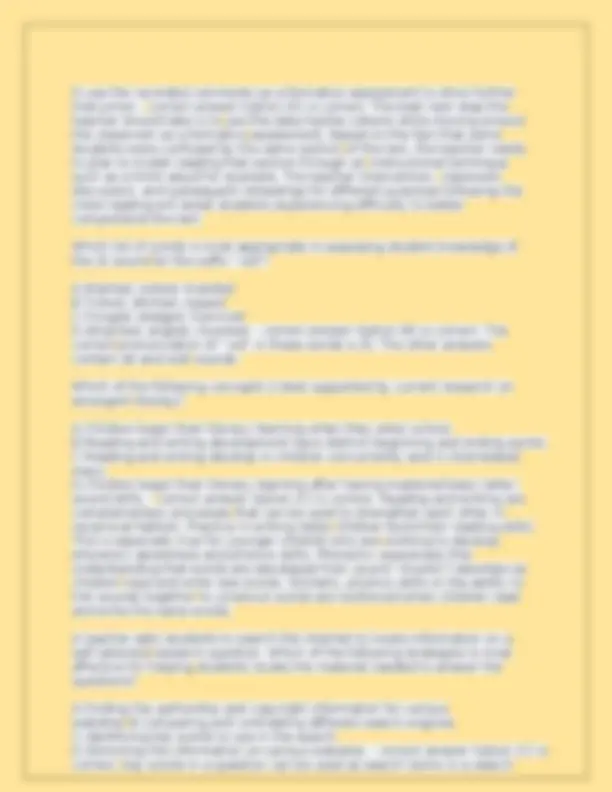
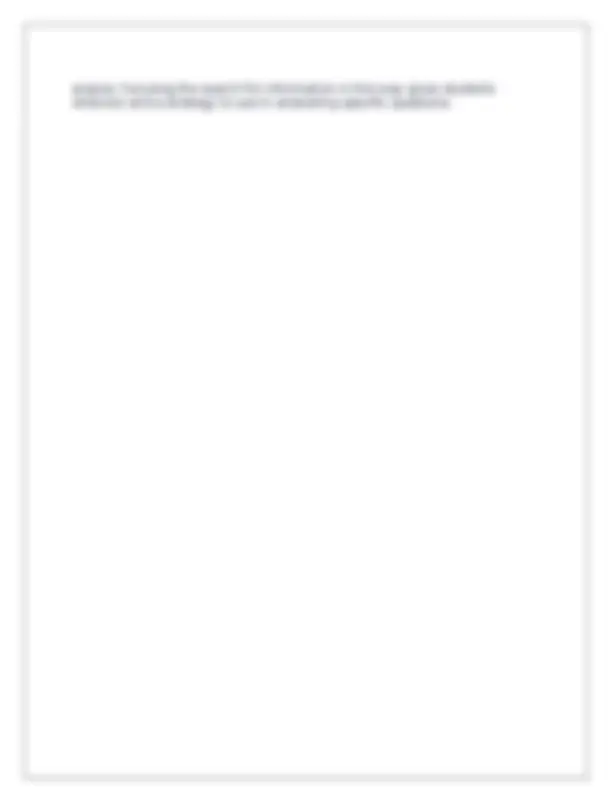
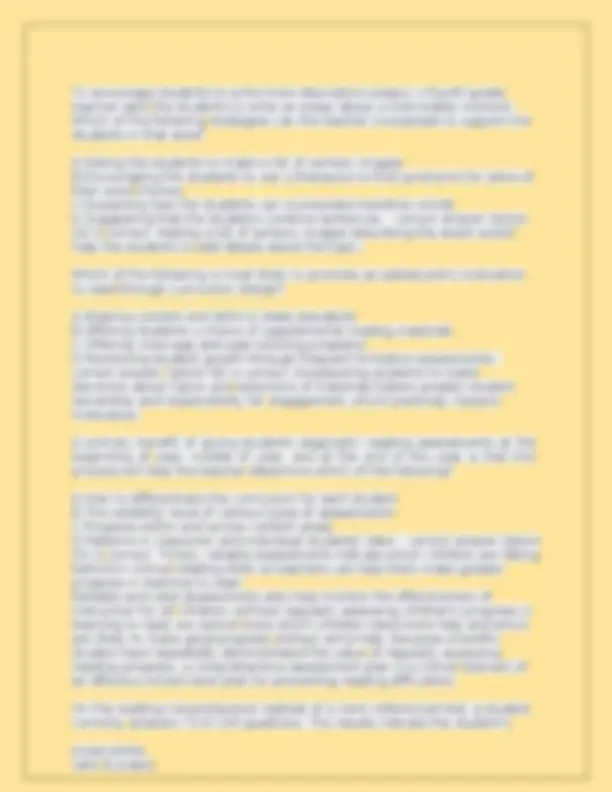

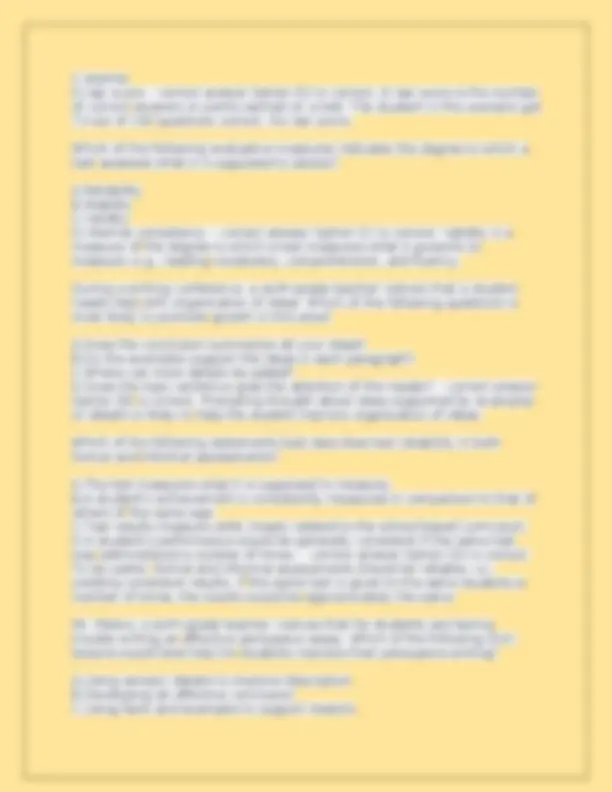
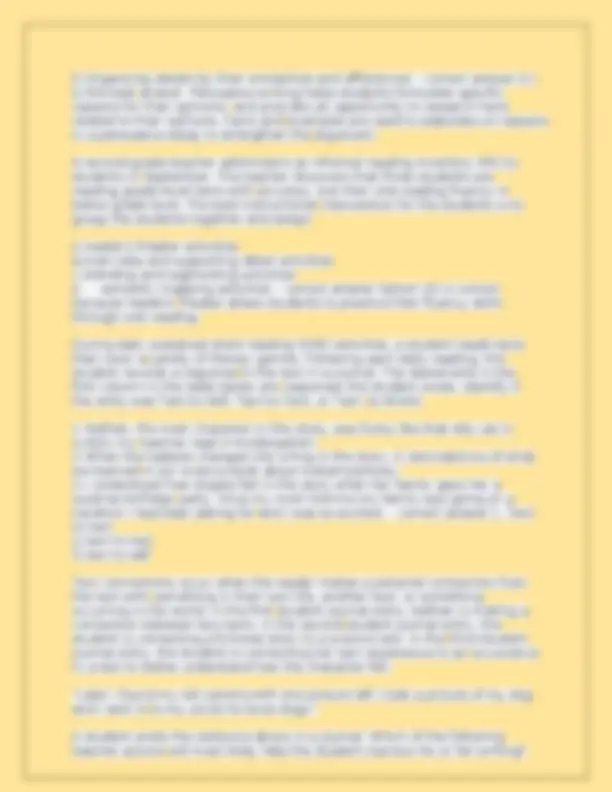
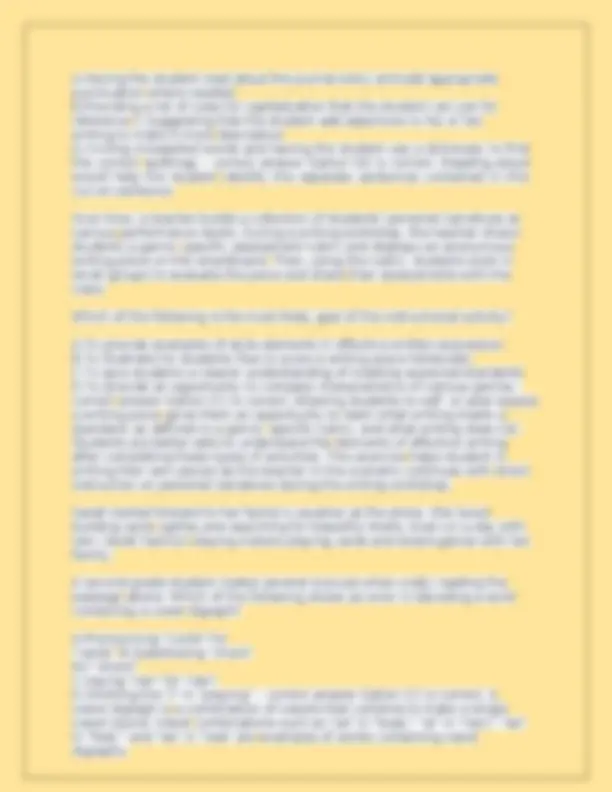
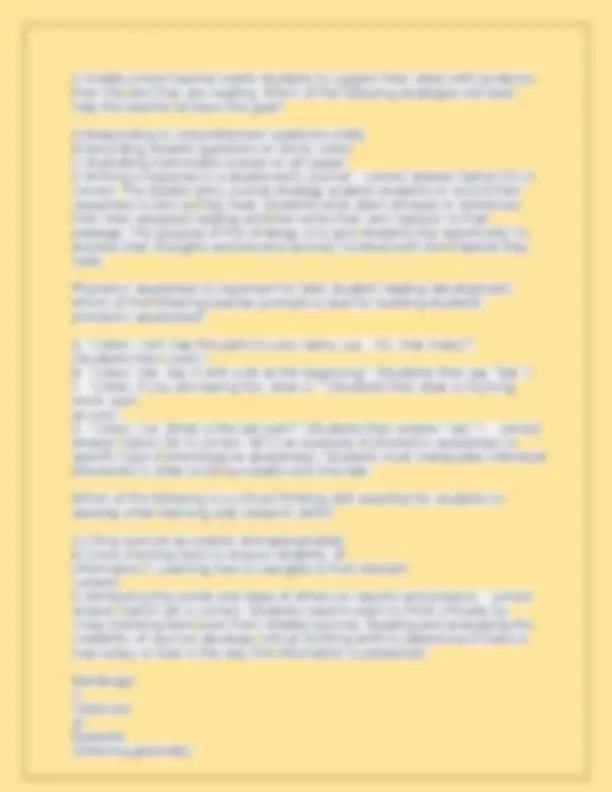
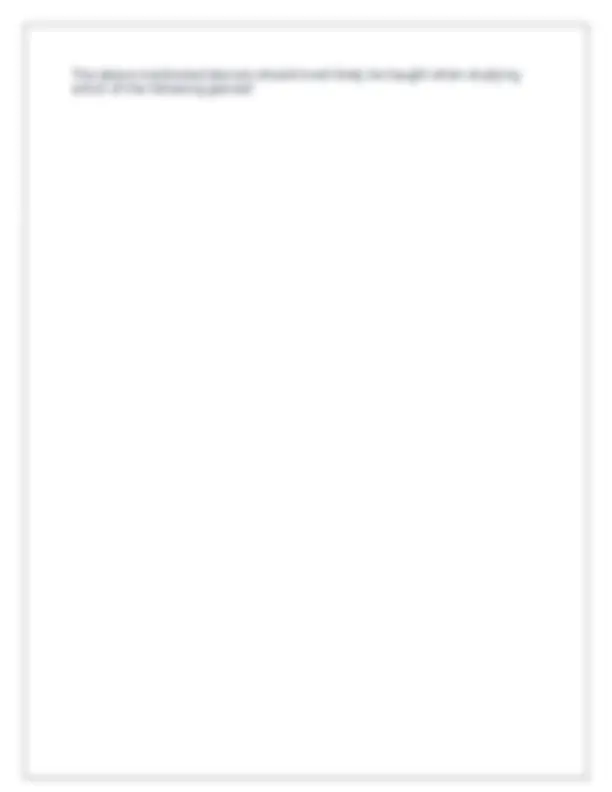
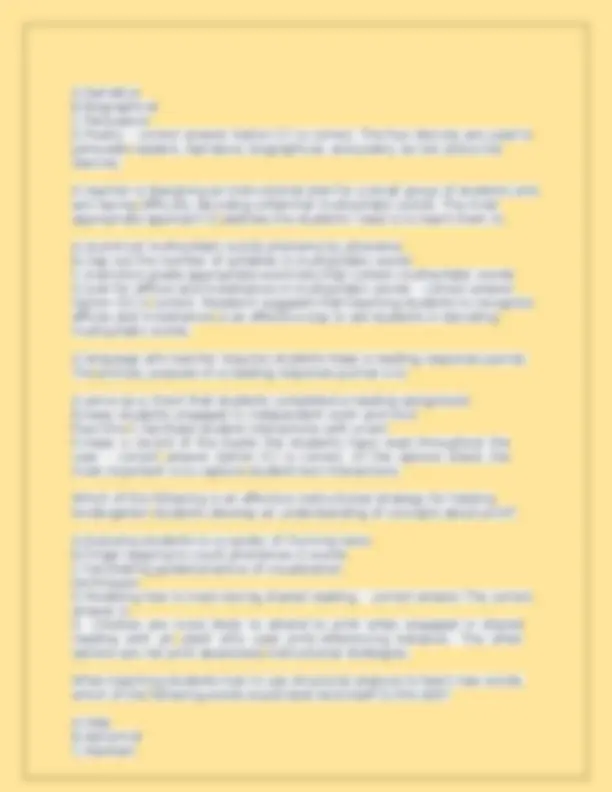
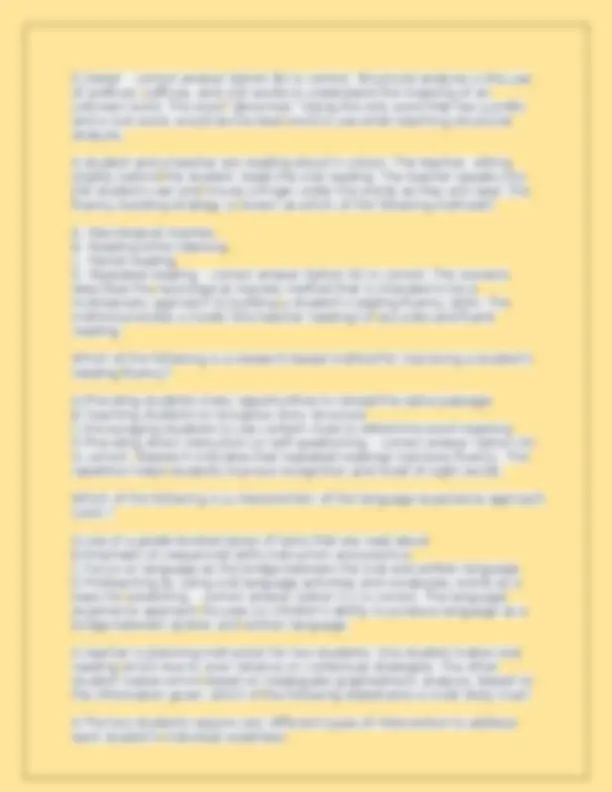
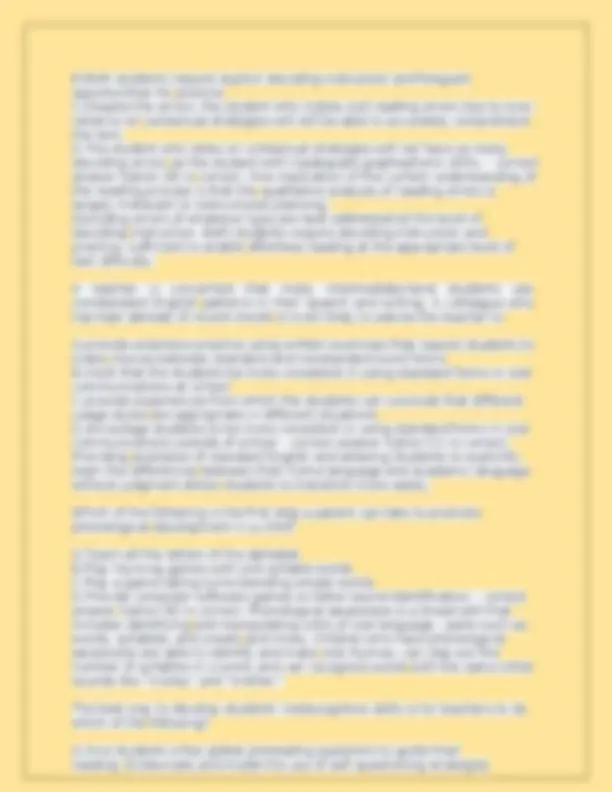

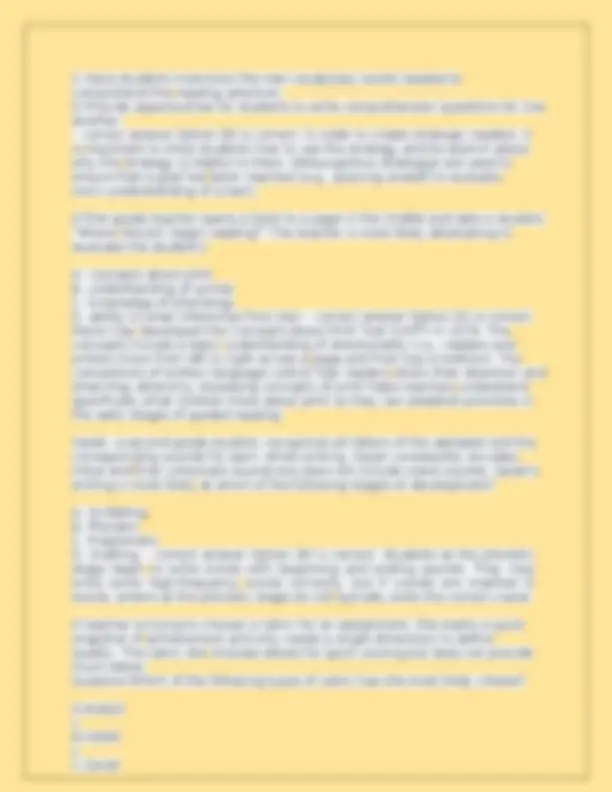

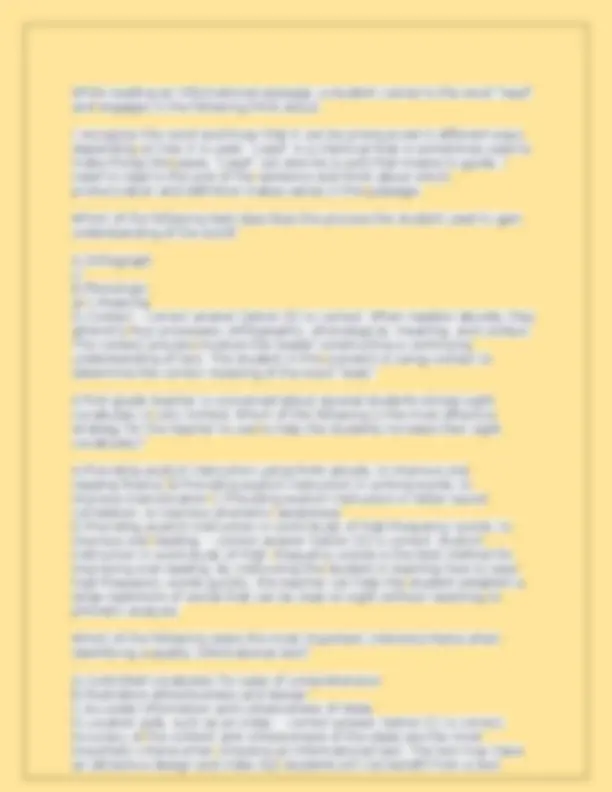


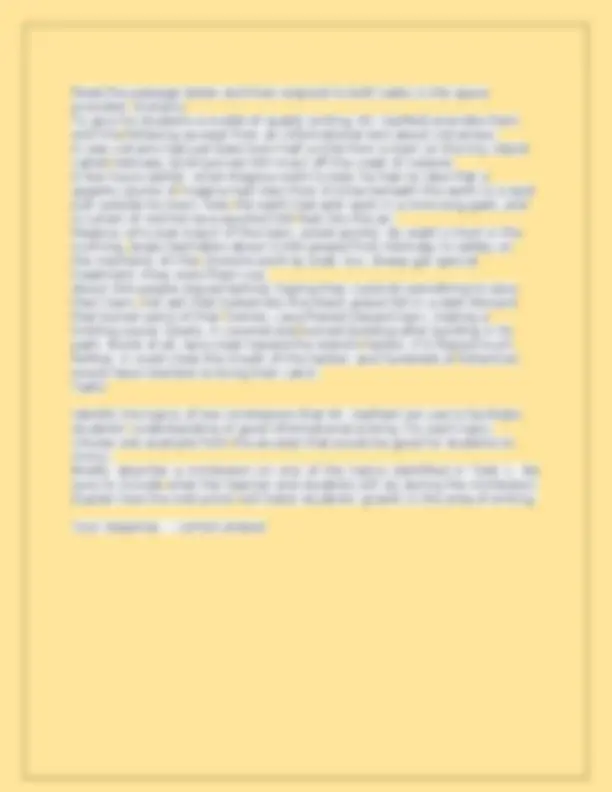


Study with the several resources on Docsity

Earn points by helping other students or get them with a premium plan


Prepare for your exams
Study with the several resources on Docsity

Earn points to download
Earn points by helping other students or get them with a premium plan
Community
Ask the community for help and clear up your study doubts
Discover the best universities in your country according to Docsity users
Free resources
Download our free guides on studying techniques, anxiety management strategies, and thesis advice from Docsity tutors
RVE PRACTICE TEST Questions with Correct Answers 2024
Typology: Exams
1 / 46

This page cannot be seen from the preview
Don't miss anything!







































Which of the following is the best reason for using flexible grouping in the reading classroom? A.Flexible grouping allows teachers to tailor instruction to address students' changing needs. B.Flexible grouping ensures opportunities for students to have discussions around a common text with their peers. C.Flexible grouping allows students to get comfortable working with the same group of peers throughout the school year. D. Flexible grouping provides time for students to progress through a set of materials. - correct answer Option (A) is correct. When teachers use flexible grouping they are considering the always-changing strengths and weaknesses of students and they can group the students temporarily to best meet instructional needs. The other options do not address the main purpose of using flexible grouping. Which of the following is the primary purpose of a norm-referenced test? A.Interpreting a student's performance using set criteria B.Measuring how well a student has learned content-specific knowledge and skills C.Indicating where a student performs in comparison to a group of similar students D.Evaluating a student's performance compared to a standard - correct answer Option (C) is correct. Norm-referenced tests allow a student's skills to be compared with the skills of other students in a similar age group. These tests are developed by administering a set of test items to a group of students; the performance of those in the norming group is used as a basis for comparison. A student at the conventional stage of writing development will primarily write A. a combination of letters, symbols, and shapes in random order
B. words that are often correctly spelled and include storybook language such as "Once upon a time"
C.Linguistic processing capacity D.Instructional level - correct answer Option (B) is correct because when a teacher reads a series of graded texts to a student, the teacher is assessing the student's ability to comprehend written language when the student doesn't have to attend to decoding issues which are present when the text is read by the student. Ms. Osborn teaches a variety of reading strategies to help her students become strategic readers. The strategies include predicting, previewing, monitoring comprehension while reading, generating questions, and summarizing. Which of the following most likely explains Ms. Osborn's purpose in teaching the strategies? A.Research has shown that reading comprehension improves when teachers provide explicit instruction. B.The school district mandates that students receive instruction in reading- comprehension strategies. C.Research has shown that only these strategies are effective. D.The school literacy coach has given workshops in the use of the strategies. - correct answer Option (A) is correct. According to research cited in Reutzel and Cooter's Strategies for Reading Assessment and Instruction: Helping Every Child Succeed, evidence supports that providing explicit instruction in comprehension strategies improves student literacy development.
C.Listen to this word: "sad." How many sounds do you hear? D.Which of these two words have the same medial sound: "fit," "bin," "can"? - correct answer Option (C) is correct. When segmenting words into sounds, the student listens for and identifies phonemes in the word. My vacation was exciteing. We did many interesting things. We went to the beach. We played in the sand. We were so hot that we went in the wuter. We played games in the water. We had an awesome time. A third-grade student wrote the story above about her summer vacation. To further develop the student's writing, the focus of instruction during a writing conference should be on A. word choice B. sentence variety C. spelling rules D. focus - correct answer Option (B) is correct. The student begins most sentences with "we," and the sentences are all the same type and length. To make the writing more interesting and cohesive, the student would benefit most from instruction in writing different types of sentences and sentences of different lengths. First-grade students Porter and Henry are working together in a learning center where they are listening to a series of words recorded by the teacher. Each student taps out the speech sounds they hear in the words and then checks with the other student to see if he agrees. The primary benefit of the activity for the students is that it A. reinforces phonemic awareness B. provides practice in working cooperatively C. helps develop auditory discrimination D. helps develop rhyming skills - correct answer Option (A) is correct. Phonemic awareness refers to a student's basic knowledge that spoken language is composed of a series of individual speech sounds known as phonemes. Having a strong sense of phonemic awareness is a good predictor of whether a student will experience success in learning to read. Which of the following is the most accurate statement about the process of language acquisition in young children?
A. Young children understand full sentences at a relatively late stage in language development. B. Young children exhibit random, highly variable errors in sentence construction. C. Young children infer the underlying rules of language to which they are exposed. D. Young children require planned early instructional intervention to master the language's grammar. - correct answer Option (C) is correct. According to psycholinguists and others who specialize in human growth and development, young children infer the underlying rules of language to which they are exposed and begin to acquire the ability to communicate through the testing of what they have learned (hypothesis testing). Which of the following words contains the soft sound of "g"? A.Wiggle B.Thought C.Urgent D. Guilt - correct answer Option (C) is correct. The "g" in "urgent" is pronounced as /j/ which is the soft sound of the letter. The word follows the phonic rule that when "g" is followed by "e", "l," or "y," it usually makes the soft sound of the grapheme. Students in a sixth-grade class are preparing to give an oral report on a famous author they have researched. Which of the following strategies would be most effective for students to do before speaking to an audience? A.Providing a copy of the report to all students in the class B.Writing key words on note cards to refer to during the presentation C.Memorizing the report before the presentation D.Creating a media-based presentation from which to read the report - correct answer Option (B) is correct. When students have completed their research projects and are asked to develop an oral report, they should consider how to present information that will be both interesting and well organized. Students should write the key words or phrases from the information they want to present on note cards to help them recall the material. The words "accommodate" and "television" each have how many syllables? A.Two
be got kite mail Which of the following skills does the chart best reinforce? A. Spelling of rhyming words B. Knowledge of vowel patterns C. Understanding of beginning consonant sounds D. Knowledge of consonant digraphs - correct answer Option (B) is correct. The categories are common vowel patterns, and sorting words into the categories reinforces students' familiarity with the patterns in both their reading and their writing. A first-grade teacher plans to instruct students in the decoding strategy of dividing phonetically regular words into onsets and rimes. Which of the following words is best for the teacher to use to most effectively model the skill? A.Stop B.Catch C.Break D.Want - correct answer Option (A) is correct. Teaching beginning readers about onsets and rimes helps them recognize common phonetically regular chunks within words. This knowledge can help readers decode new words with similar spelling patterns. "Stop" contains the major phonogram "-op," knowledge of which assists students in decoding unknown words with the same phoneme-grapheme pattern. While observing a student reading, the teacher notices that the student does not match letters with their correct sounds. The student is most likely having problems with A.comprehension B.syntax C.graphophonic cues D. reading fluency - correct answer Option (C) is correct. The student seems to be having trouble with letter-sound correspondence. ("Graph," which means print, and "phonic," which means sound, refer to letter- sound correspondence.) A student who reads with expression, appropriate phrasing, and good inflection, is described as reading with
A.generalization B.inference C.intensity D. prosody - correct answer Option (D) is correct. Prosody is the appropriate use of phrasing and expression to convey meaning. Teacher: What is the first sound in van? Student: The first sound in van is /v/. The teacher is assessing the student's ability to do which of the following phonemic awareness tasks? A.Phoneme isolation B.Phoneme categorization C.Phoneme blending D.Phoneme segmentation - correct answer Option (A) is correct. The student is isolating the initial sound /v/ from the rest of the word. Phoneme isolation requires the recognition of individual sounds within a word, which is what the student is doing in identifying the first sound in "van." To promote family involvement in literacy activities, teachers can encourage parents to A. buy comics and story books B. get their child a library card C. discuss stories and experiences at home D. volunteer in the school's media center - correct answer Option (C) is correct. This practice is recommended based on research by Jim Trelease and the National Institute of Education's Commission on Reading. Discussing stories and experiences at home promotes family involvement and increases oral language and vocabulary development, both of which are critical to achieving literacy success. Of the following, the most appropriate way to assess whether students have generalized the skills acquired in a unit on recognizing and correcting punctuation errors is to have the students A.proofread a short passage and correct any punctuation errors it contains
"What do you think are the important words from the article?" "How do these words go together?"
"What words do you already know?" As the students answer, Ms. Stewart has them refer to the word cloud characteristics to support their answers. The best reason for using the strategy is to help students learn to A.define unknown words using resources such as a glossary B.build academic vocabulary by making connections between key words C.apply the meaning of new words by using them in complete sentences D. identify synonyms for key words that most students already know - correct answer Option (B) is correct because the teacher pulled the vocabulary words from the article and created a word cloud. A student has completed the following word sort: Flaps Table Cat Fail Mask Aim Slab Mats Which of the following did the student sort incorrectly? A.Flaps B.Aim C.Cat D.Mats - correct answer Option (D) is correct. This is correct because "mats" should be in the short vowel column as it does not say the name of the letter when uttering it. Since it is in the long vowel column this response would be correct. Indicate whether or not the practices listed below are appropriate for children who are learning English as a second language. Note if they are Appropriate (A) or Not Appropriate (N)
application so that students are listening for the details and main ideas.
Which of the following strategies is most likely to increase students' motivation for silent sustained reading? A.Several times a week the teacher selects different books from the classroom library and reads short passages to the students B.The teacher selects a favorite book from the classroom library and reads the entire story to the class. C.The students are allowed to choose any book from the classroom library and then read it aloud to the class. D. On a monthly basis, students are assigned to read any book they choose and then write a short summary. - correct answer Option (A) is correct. By introducing several books throughout the week to the class, the teacher encourages students' interest in selecting books for independent reading. Since the teacher is reading just a short part of the book, the students will want to read the book to find out the rest of the story. Which of the following teacher interventions is most effective when readers lack the knowledge to read a text on an unfamiliar topic? A.Teaching new vocabulary as a pre-reading step B.Providing relevant background information C.Questioning students to determine prior knowledge D. Reading the text aloud before asking students to read silently - correct answer Option (B) is correct. Giving students background information on an unfamiliar topic provides a conceptual framework from which students can access the content. After studying a classic novel, which of the following instructional activities should a middle school reading teacher include in a lesson to best promote student higher-order thinking? A.Creating a backstory for a secondary character in the novel that explains his or her behavior in the book B.Reading other texts by the same author and then identifying character similarities across texts C.Answering comprehension questions that require textual evidence to support the answers D.Viewing an excerpt of a video version of the novel to observe the character interaction and setting - correct answer Option (A) is correct. To promote higher-order thinking is
In a fifth-grade reading class, the teacher asks students to write a list of words associated with the American Revolution. Next the teacher draws three columns on the board and labels them "British," "American," and "Both." Students are asked to come to the board and write their words in the most appropriate column. The class discusses why each word belongs in the particular column. This vocabulary-development activity is known as which of the following? A.Semantic feature analysis B.List-group-label C.Using context clues D.OPIN - correct answer Option (B) is correct. List-group-label is a vocabulary-building activity that encourages students to activate prior knowledge, share what they know about content-specific concepts, and make connections between them. A teacher wants to describe to the class a rule associated with adding a silent "e" to the end of a consonant-vowel-consonant (CVC) word. The best approach is to tell the students that when a silent "e" appears at the end of a CVC word, it cannot be heard but it will A.make the other vowel have a long sound B.make the other vowel and consonants have a blended sound C.make the other vowel have a short sound D. change the other vowel into a long "e" sound - correct answer Option (A) is correct. Because when "e" is added to a word with a consonant-vowel- consonant (CVC) combination, the initial vowel has a long sound. For example, "can" is a CVC word with a short a sound. When "e" is added to the end, the word becomes "cane" and the "a" has a long sound. A fifth-grade teacher asks students to complete the following writing assignment. NonFiction Text Assignment
C.Making an inference by connecting ideas within a text D.Comparing the viewpoints of different authors among multiple texts - correct answer Option (C) is correct. The assignment does address this content standard. Students are asked to demonstrate mastery of the complex task of connecting different ideas presented in the text in order to make an inference about the author's intended message or purpose. A fifth-grade teacher asks students to complete the following writing assignment. NonFiction Text Assignment